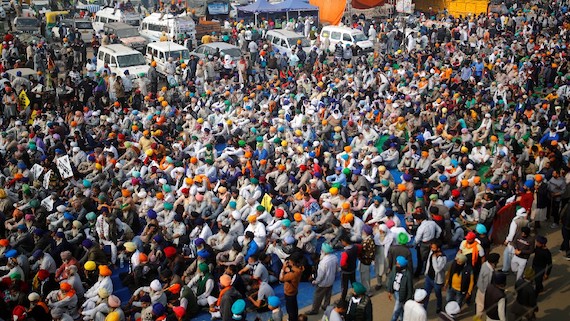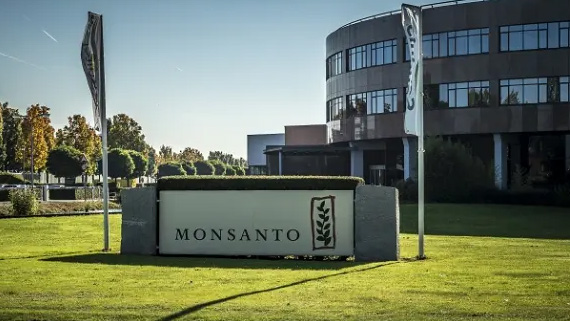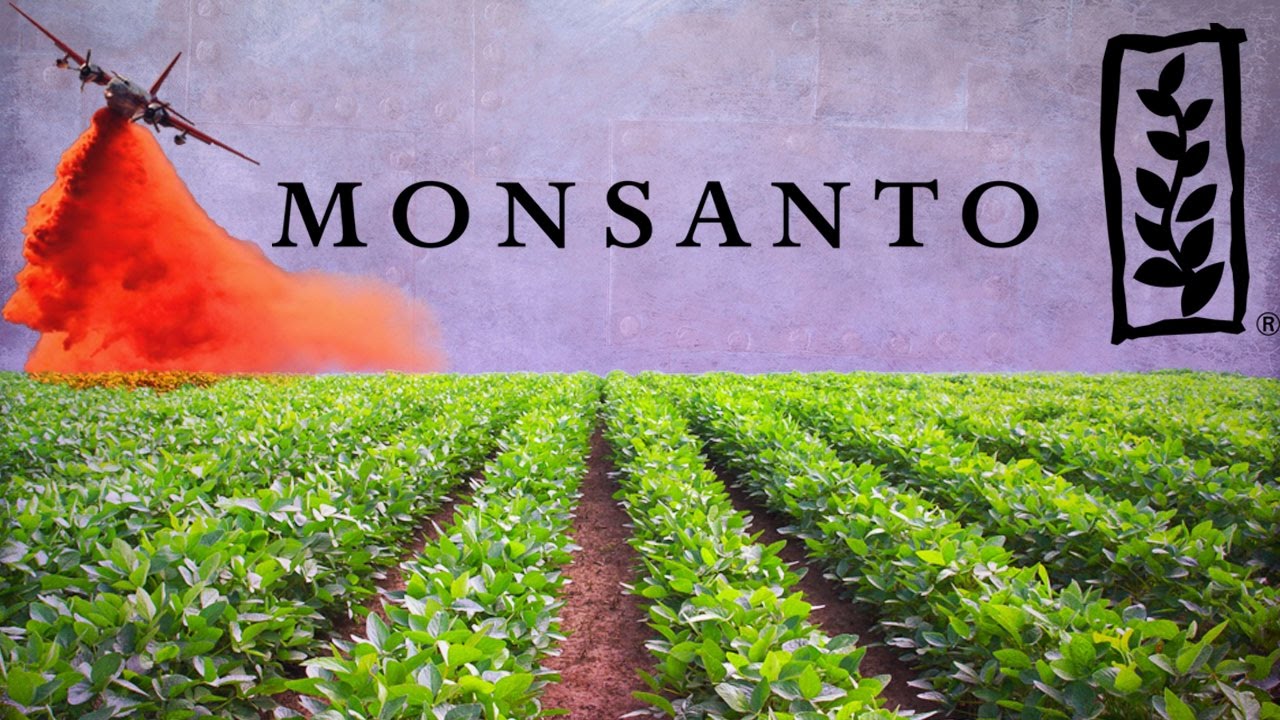Articles/Opinion » Selected Articles
GMO ITS ORIGIN AS A TOOL OF NEO-COLONIALISM & SIKH RESISTANCE FROM INDIAN SUB-CONTINENT
January 12, 2021 | By Ramnik Singh
Instead of considering this text as an opinion article, research paper or report, it is my humble request to consider this as either a conversation or an open letter that may serve as a mode of awareness about an impeding existential threat to the people of the Indian sub-continent in general and freedom of humanity as we currently know. In present times we are staring at a grim future which will be nothing in terms of social or economic order like the one we inherited from our ancestors’. In the words of British political thinker George Orwell, the really freighting thing about totalitarianism is not only it commits atrocities but also attacks the ‘objective truth’. This we can further interpret that man is meant to be free & independent in all aspects of life be it social, political, spiritual and financial (economic). We are entering a world order where human dignity and freedom will be bootfaced by the dedicated group of elites be it from political, intellectual or big billionaire global corporates.MODI
The current on going farmer agitation in the Indian union where hundreds and thousands of farmers lead by Sikhs of Panjab have converged around New Delhi to protest against three controversial farm bills passed by the ruling central government, in fact it shall be seen as a resistance movement against the big global corporate elites who are hell bend to impose their version of new world order (absolute control & totalitarianism) through their quasi global institutions like World Bank, IMF (International Monetary Fund) and the WTO (World Trade Organization). In this case by far it seems that the methodology adopted to implement the agenda of new world order seems to be that of Weaponization of Food in commercial terms. It is an agenda by which the big corporates are trying to establish a foot hold and ultimately monopoly on all the aspects of agriculture such as food production, storage, distribution, amount of quantity to be produce and modulate the quality (amount/type of nutrition) intake among the targeted human population.

A view of Farmers’ protest at a border of Delhi
As per those three controversial bills, the big private corporates will be able to enter into contract farming with the farmers as a result, in order to move forward with their respective objectives those corporation will be introducing GM (Genetically Modified) seeds and make farmers to cultivate the same. GM seeds are the seeds that are purportedly resistant to herbicides or pests & are claimed to provide high crop yield. Monsanto is the leading agrochemical & agriculture biotech company when it comes to research and production of GM seeds. It has as a history of harassing and exploiting farmers specially small scale ones by ensuing legal action against them for infringing its patent rights on GM seeds, from 1997 to 2010 it filed 144 lawsuits against family farmers & 700 were settled out of court. That means Monsanto sued those farmers for using patented GM seeds of transgenic crops such as corn, soyabean and cotton, this ultimately lead to obliteration of competition from the US food market. Since the GM seeds produced by Monsanto was only compatible with Roundup herbicides & pesticides, (a subsidiary of Monsanto) the farmers had no choice but to use Roundup herbicides, this double the profits of the company in 2012 up to $ 2.94 billion dollars.
After Monsanto was taken over by Bayer, a Germen pharmaceutical company it is believed that both control around 61 percent of global biotech market. From above it is easy to gauge that the big corporates like Monsanto-Bayer controls all the major resources of input that are require in the agro industry which ultimately leads to conclusion that they have capability to control every aspect of human food consumption.

As per an article published in June 2015 by Green America, an environmental magazine, a major chunk of GMO based food is neither used for direct human consumption and nor it is a viable option to increase the food production as it adversely effects the local agroecology. The GMO based crops either goes for animal feed or is used for producing industrial scale ethanol (which is used with Petrol in most of the developed economies in order to reduce greenhouse emissions caused by automobiles). The article further states that the GMO seeds are not designed for increasing yield per acre, instead they are designed to withstand and work-in partnership with the pesticides manufactured by the same companies manufacturing the GMO seeds (about which it was mentioned in the last paragraph). Moreover, these seeds can’t stand extreme weather conditions such as drought and they are not even compatible to the local ecology in general and agroecology in particular. What increase in yield from GE (Genetically Engineered) is achieved is a direct result from decrease in yield lost to pests from Bt crops, pesticides, and an increase in fertilizer use (made from petroleum, defeating the purpose of ethanol). Unfortunately, growing weed and pest resistance is already decreasing their (Monsanto made pesticides) effectiveness, requiring much more dangerous pesticides and making useless one of the most used organic pesticides, Bt. These minimal increases in yield have come with major externalities, including but not limited to water pollution, pollinator loss, and soil degradation putting food security at risk. Big biotech companies such has Monsanto-Bayer have failed to develop a GM seeds that with increasing yield per acre also consumes less water.

Both in terms of economic and environmental cost the conventional breeding outperforms the GMO seeds. It is stated that it takes around 10 years and an investment of $ 150 million to develop a GM based crop. On the other hand, it takes around $ 1 million to produce same quantity of conventional crops through conventional breeding with some improvements in the techniques of Water Use Efficiency (WUE).
So, the question that should come to our mind is why are the governments of the developing countries through their respective propaganda machinery are trying to sell us this already vindicated pack of lies and failed GMO program by stating that GM is the future of agriculture and a way to end world hunger. For the answer we will have to go back to year 2008 when world was reeling under financial crises when the world market collapsed. The world economic crises of 2008 lead to the collapse of the property (Real estate) market, as a result most of the speculators in search of new market moved over to agriculture market. These speculators with good quality of liquidity (funds) started buying futures on the food commodity market that too in a reckless manner as the market at that time was under-regulated. This drove the world food prices between 2008-11 on 30 years record high and created famine like situation in so-called third world countries. This economic crisis followed by financial speculation on food commodities which lead to a spike in global food prices to a record high sparked a global ‘land rush’. It triggered a cross border land acquisitions not only by those companies relevant to the agroindustry, but also by global financial elites such as wealth fund, private equity, pension fund- managers, commercial banks etc. This will assist them to control, regulate and manage the open market driving force of the food (agriculture industry) that is demand and supply as they will be at the ownership of the means of production (land, seeds, fertilisers & credit). This phenomenon is known as financialization of food and agriculture.

It is due to the exorbitant amount of profit generation viability in the financializaton of food and agriculture sector has that the big corporates have come up with multi-dimensional lies & myths about GMOs in order to push its acceptability among the general masses, as well as the farming community. Let us discuss some of these myths or justification that are given by these exclusive big corporates like Monsanto, Bayer, Dupont and Dow chemicals in order to push GMO seeds usage among the farming community.
MYTH: GMO Crops Will Increase Productivity and End World Hunger.
Fact: GMO crops has nothing to do with ending world hunger and increase food productivity. FAO data clearly states that there is enough food production and availability to feed the world population that too without GM seeds. The current hunger problem is more or less related to faulty economic policies, poverty and lack of transportation storage & distribution infrastructure specially in the developing countries. On the contrary the produce from GMO crops are not even designed mainly for human consumption, majority of the crops like soyabean, canola, corn, cotton etc are used to make cattle feed, ethanol for cars and other industrial oils. Moreover, as per the study conducted by the scientists in US concluded that the genetically engineered soyabean & corn seeds had same amount of productivity per acre as their conventional counterparts.
MYTH: GE Crops help Eliminating Harmful Agrichemicals
Fact: It’s the opposite, GE crops increases the harmful use of agrichemicals Industry people try to put this myth over by touting the “Bt gene” from the Bacillus thuringiensis bacteria, which produces a toxin lethal to some corn and cotton worms. The plants produce their own pesticide, supposedly obviating the need to spray. But with such large areas planted to Bt monocultures, the worms have quickly developed resistance to Bt; worse, a host of formerly unknown secondary pests now have to be controlled with more chemicals.

Argentina for example had no land area under soyabean crop 30 years ago. With the introduction of GM seeds of soyabeans half of country’s cultivable land is under soya bean. Simultaneously, the amount of herbicides sprayed skyrocketed form 8 millions liters in 1995 to 240 million liters in 2010.
MYTH: GE crops pose no harm to human health and environment.
Fact: GM crops can be anything but “safe” for human health and ecology in particular. Do we really want to entrust our healthy to an agriculture system run by profit hungry crony corporates? Nevertheless, our plates are now filling up with food items from plants with altered DNA and heavy pesticides loads, and we are told to simply shut up and eat it.
Dr Gilles-Eric Seralini conducted an experiment to study the effects of glyphosate tolerant GM maize on rats. His study concluded that there is more than casual association between GM food crop and adverse health effects.
University of Leipzig found high concentration of glyphosate in both human and cattle urine 5 to 20 times greater than acceptable limits. Its adverse effects are also well documented.
Professor Andres Carrasco of CONICET-UBA molecular embryology lab at the university of Buenos Aires has unveiled a study showing that glyphosate herbicides can cause malformation in frog and chicken embryos at does much lower than required for agriculture use.
Two quasi global institutes, World Bank (WB) and International Monetary Fund (IMF) acted as front offices of the global financial and corporate elites to achieve this feat for them. Both the WB & IMF have propagated to the developing countries that the only way to progress and welfare is to have a deregulated open market with economic resources being allocated efficiently. But in order to get funding and financial assistance from these institutions the governments of the developing countries had to comply and implement “neo-liberal policies”. These polices often termed as Structural Adjustment Policies (SAP) could range from deregulation or disinvestment (government pulling itself out of a particular industry) cutting welfare and subsidy spending by the government, privatisation of public infrastructure like airports, railway station, sea ports, highways introducing some special provisions which shall make it easy for the foreign investors to get the ownership of the natural resources of that particular country. All these SAPs are introduced under the guise of “easy of doing business” has resulted in more capital accumulation in the hands of global elites and loss of livelihood for local communities. The World Bank on its official website has stated clearly that it provides both advisory and risk management services to the financial investors it does more or less vindicates its claim of working for poverty alleviation and economic prosperity.
It was the global economic crises of 2008 that gave a push to a new wave of SAPs by these quasi international institution to the governments of developing countries under the smoke-screen of technical assistance and advisory services. The aim is to provide conductive investment climate to the global corporates and financial elites. Policy change related to agriculture especially opening up of new markets for the GMO seeds in the developing countries including India can be seen as continuation of the new policy reforms dictated by the WB and well as the IMF, as the aim is to achieve industrial scale production of food in the agriculture sector which in turn will help promote financialization i.e capital accumulation and accumulation of power and wealth by financial elites as discussed previously, the total deregulation of the agriculture sector and market lead land reforms will facilitate the private investor to access large scale land deals in developing countries (India).
The Controversial Bills Namely: – Bill on Farmer’s produce trade and commerce, Bill on contract farming and lastly Bill relating to the essential commodities passed by Narendra Modi lead Indian government are the manifestation of policy changes pushed and lobbied by the IMF. Rolling back on social welfare, oil, fertiliser and power subsidies by either central or state government in India, opening up Foreign Direct Investment (FDI), privatisation of public infrastructure such as Air India, Indian railways, telecommunications, Sea ports etc can be termed as classic examples of SATs dictated by the IMF.
Another aspect responsible for this ongoing current economic mess in India is the growth of retail based ecommerce platform that is projected to grow close to $ 6.44 trillion US by the year 2022. It will be easier to understand that the one who controls or enjoys monopoly in the means of production shall dominate and reap the benefits of a particular industry and agricultural products forms a lion’s share in this retail market. In a report by World Bank in December 2019 it forwards its recommendation about the business avenues and aspects in India for ecommerce platform, provided with conductive “business environment”(SAPs). An Economic forum called Indian Brand Equity Forum (IBEF) has pegged India’s growth in e-commerce platform from US$ 38.5 billion in 2017 to US$ 200 billion by 2026. During the early stages of the Corona Virus lockdown in India in the words of EY India, a business consultancy firm “there was a sudden influx (boom) of financial investment in food related e commerce platform.”
To our good fortune it us the Sikhs of Panjab who have given the first ever strong, visible and organised resistance to this juggernaut of neo-imperialism in the form of crony capitalism, so it is about time that we urgently start coming up with best of ideas and efforts in order to counter the narratives given by these powerful institutions backed by the machinery of the nation state which is hell bend to alter individuals sovereign life forms (Human) into means of production.
Ramnik Singh
ramneek.502@gmail.com
To Get Sikh Siyasat News Alerts via WhatsApp:
(1) Save Our WhatsApp Number 0091-855-606-7689 to your phone contacts; and
(2) Send us Your Name via WhatsApp. Click Here to Send WhatsApp Message Now.
Sikh Siyasat is on Telegram Now. Subscribe to our Telegram Channel
Related Topics: BJP, Monsantro, Narendra Modi




